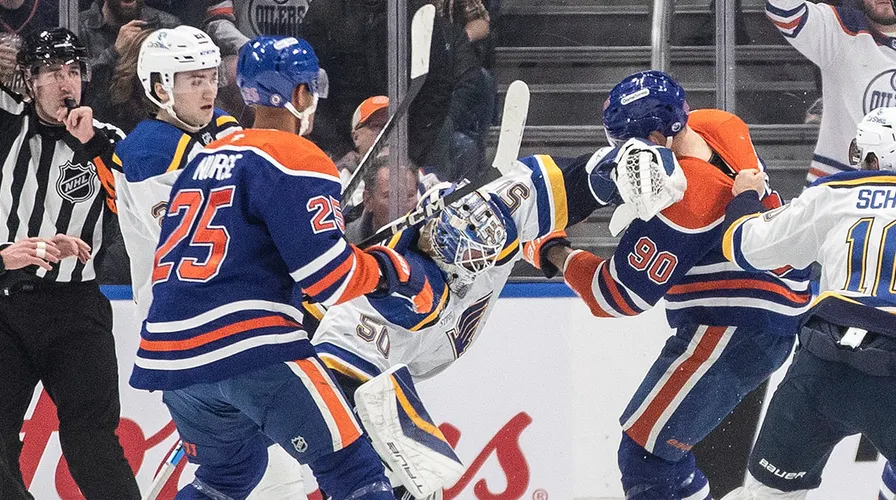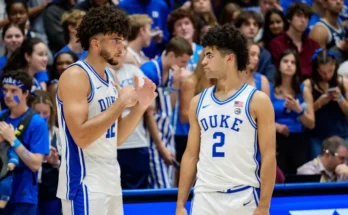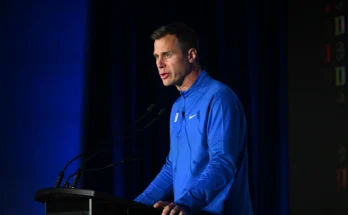Early in a pivotal game, Jordan Binnington of the Blues and Corey Perry of the Oilers fight.
In the world of professional ice hockey, the intensity of the game often escalates quickly. Physicality, rivalries, and emotions run high, making moments of confrontation almost inevitable. One of the most intriguing and jaw-dropping confrontations unfolded early in a pivotal game, as St. Louis Blues goaltender Jordan Binnington squared off against veteran forward Corey Perry of the Edmonton Oilers. The fight, which took place in the opening moments of the match, instantly set the tone for what would prove to be an electrifying contest.
This altercation didn’t just captivate fans with its unexpected nature—it also held significant implications for both teams’ playoff aspirations. The tension that had been building between the two players finally erupted in an unprecedented showdown, leaving both players and their respective teams with a lot to prove. Here’s a breakdown of the fight, its context, and the impact it had on the rest of the game and the season for both the Blues and the Oilers.
The Players: Binnington and Perry’s Historical Background
To truly understand the significance of this fight, it’s important to examine the two players involved: Jordan Binnington and Corey Perry.
Jordan Binnington has long been one of the more polarizing figures in the NHL. Known for his fiery temperament and unrelenting competitive nature, Binnington has often found himself at the center of controversy. As the starting goaltender for the St. Louis Blues, Binnington has made a name for himself not just for his goaltending prowess, but for his fiery responses to opposing players. His confrontational style has earned him a reputation as a goaltender unafraid to get involved physically when the situation calls for it.
Corey Perry, on the other hand, is a seasoned forward with a reputation for playing on the edge. The Canadian has spent his career making his presence felt in the physical and gritty areas of the game. Perry is no stranger to stirring up emotions among opponents, and his combative style has led him to engage in numerous skirmishes over the years. While his skill on the ice is undeniable—having won multiple awards, including the Hart Trophy—Perry’s ability to get under the skin of rivals is equally noteworthy.
Both players have, at various points in their careers, become the focus of media attention for their fiery personalities. Their tendency to engage in physical battles makes them both leaders in their respective teams’ emotional makeup. In a game that had playoff implications, their clash seemed inevitable.
The Situation: A Pivotal Game
The timing of the fight was crucial. Both the St. Louis Blues and the Edmonton Oilers were fighting for valuable playoff positioning, and every point mattered. With the standings tight, each team was looking to gain any advantage they could, and the early minutes of this game would prove to be pivotal.
The game started as any other high-stakes contest would—intense, high-energy, and filled with anticipation. However, the game took an unexpected turn just minutes into the first period. As the Blues and Oilers squared off in what was already shaping up to be a physical battle, the two players found themselves in a confrontation that would ignite the game and alter its course.
The altercation began when Corey Perry made a play in front of Binnington’s crease, a place where goalies are known to be particularly protective. Perry, known for his scrappy style, tried to establish position and, in the process, nudged Binnington. What followed was a series of words exchanged between the two players, and soon enough, tempers flared.
Jordan Binnington, never one to shy away from confrontation, immediately skated out from his crease and exchanged heated words with Perry. It was clear that both players had their sights set on one another, and the tension in the building began to rise. The crowd could feel the shift in energy—this wasn’t going to be a typical game.
In a flash, the two players dropped their gloves and squared off in front of the net, setting the stage for an all-out battle. The rest of the players on the ice quickly realized what was happening, and a brief moment of chaos ensued as they tried to separate the combatants. But this was a moment neither Binnington nor Perry was willing to back down from. Their fight was symbolic of the kind of grit and determination each player embodies—fighting for their team, their position, and the emotional tone of the game.
The Fight: A Physical Battle
When the gloves came off, the two players went at it with a mix of intensity and strategy. Jordan Binnington, known for his aggressiveness, wasted no time throwing punches, while Corey Perry, a veteran fighter, relied on his experience to try and gain the upper hand.
Binnington’s goaltender instincts kicked in as he tried to avoid Perry’s grips, but Perry’s tenacity made him a difficult opponent to disengage from. The two players grappled for what seemed like an eternity, with neither giving ground. In an environment where even the slightest slip-up could lead to a costly mistake, both players were fighting not just for the immediate advantage but also to establish dominance early in a critical game.
The fight eventually ended with officials rushing in to break it up, and both players were sent to the penalty box. The intensity of the altercation set the stage for what would become a chippy and emotional game. Fans in the arena erupted into cheers, while others sat stunned, processing the fact that one of the league’s top goaltenders had just dropped the gloves with a veteran forward in the opening minutes.
The Fallout: Impact on the Game
The fight between Binnington and Perry was more than just a momentary distraction—it had lasting implications for the rest of the game and the two teams’ performance.
St. Louis Blues: For the Blues, the fight seemed to light a fire under the team. While Binnington’s physicality and willingness to stand up for himself and his team were never in question, this altercation seemed to boost the Blues’ energy. As one of the most emotional players on the team, Binnington’s actions in this fight appeared to rally his teammates around him. The Blues would go on to play with renewed vigor, as the fight seemed to embody the hard-nosed style they needed to succeed.
However, the altercation also put additional pressure on Binnington, as his focus was split between the fight and his goaltending duties. His ability to stay composed would be critical as the game wore on, and it remained to be seen how well he would recover mentally from the distraction. The Blues’ ability to channel the fight into a positive force would depend on Binnington’s leadership and focus.
Edmonton Oilers: On the other side, the Oilers found themselves reacting to the fight in a way that exposed their frustration. As a high-powered offensive team, the Oilers were not accustomed to getting bogged down in physical altercations early in games. Corey Perry’s actions seemed to disrupt the Oilers’ rhythm, forcing them to respond not just on the scoreboard but in terms of their physicality. This meant that the Oilers had to adjust their approach, which sometimes led to costly mistakes.
Perry’s fight also placed him in a difficult position, as he would now have to deal with the physical toll of engaging in such an early battle. The Oilers’ penalty kill would need to step up, as losing Perry could prove costly given his leadership role. The team’s response to the early fight would play a large part in determining whether the Oilers could bounce back and reclaim control of the game.
The Broader Impact: A Turning Point
Beyond the immediate impact of the fight, the altercation between Binnington and Perry had broader implications for both teams. The emotional energy and the physical nature of the battle set the stage for what would turn into a high-stakes game with huge playoff implications.
For the Blues, the fight seemed to symbolize their entire season—fighting for every point, every inch, and every opportunity to succeed. It was a moment that showed the team’s resilience, a trait they would need as they battled through injuries and adversity in the remainder of the regular season. Binnington’s willingness to engage physically, even as a goaltender, was a testament to his leadership style and his desire to protect his team.
For the Oilers, the fight highlighted the challenges they would face in balancing their high-scoring offense with the physical demands of the game. While they would go on to make adjustments and find a way to remain competitive, the fight exposed some cracks in their emotional resilience, as they struggled to regain control of the game after the skirmish. The Oilers would have to find a way to channel their frustration into productive hockey, learning from the fight and the situation that unfolded in front of them.
The early fight between Jordan Binnington and Corey Perry was not just a physical clash—it was a microcosm of the intensity, the stakes, and the emotional energy that defines professional hockey. What began as a simple skirmish turned into a defining moment in the game, with implications that reverberated throughout the contest. While both teams would go on to play with grit and determination, it was clear that this fight had set the stage for a game that would go down as a classic—one that showcased not just the skill of the players but their hearts, their passions, and their desire to win.
As the season moved forward, the impact of this fight would continue to linger, reminding fans of the fierce and unforgiving nature of the sport, where even the smallest moment of confrontation can turn the tide of a season.



